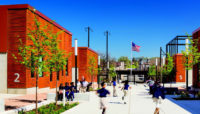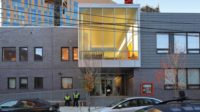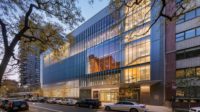In East Baltimore, the storied Johns Hopkins University School of Medicine campus, emblematized by its castlelike Queen Anne–style brick Billings Administration Building, stands in striking contrast with its environs. Around it is one of the city's most dangerous neighborhoods, where crime and poverty rates are double the city average, and street after street is lined with mostly vacant, ghostlike row houses with boarded-up windows and doors.
The nonprofit East Baltimore Development Inc. hopes that the new school—part of an 88-acre, $1.8 billion mixed-income residential and commercial redevelopment it is managing—will attract young families to the neighborhood, raise real estate values, and further drive development. Johns Hopkins contributed $15 million toward school construction and is offering subsidies to its employees who move to the neighborhood. “The school is an important way for Hopkins to show a different side of itself to the community,” says Ronald J. Daniels, who made Henderson-Hopkins a priority when he was named university president in 2009.
Rogers's scheme draws from the neighborhood's existing architectural fabric, characterized by two- and three-story brick and formstone row houses interspersed with beefier landmarks—the Italianate St. Wenceslaus church, dating to 1914; the recently renovated American Brewery building built in 1887; and Shimek's Bohemian Hall, a former church-organ factory that is now itself a Baptist church. Following the silhouette of the surrounding streets, the school consists of long rows of squat, copper-colored precast concrete facades that echo the formstone veneer of the adjacent houses, interrupted with tall translucent volumes containing large communal spaces. “We didn't want to land a spaceship in the middle of this neighborhood,” says firm principal Robert M. Rogers. “It was about being a neighborhood school and an urban school, unabashedly.”
The architects also wanted to incorporate the traditions of Baltimore neighborhoods. In East Baltimore's heyday in the 1940s and '50s, the two- or three-step marble stoops that front every row house were social centers, where neighbors gossiped and hung out; the street bonhomie was central to life in Baltimore. “There were 900-square-foot houses on this lot with two families in them, so the street had to be the gathering space,” says associate partner Vincent Lee, who grew up in Baltimore. “We wanted to reinforce that community idea of public space.”
This concept made its way into the school. Henderson-Hopkins's community amenities are grouped along the spine of a major thoroughfare, Ashland Avenue, with the school tucked behind. This organization allowed the architects to create a gated security system, with the auditorium, gym, family-resource center, and library accessible after hours. The architects preserved the facades and stoops of nine historic row houses, listed on the state historic registry, for the front of the new library along Ashland. Marble stoops from other razed buildings were repurposed as outdoor seating.
Inside, the school has a different vibe: modern, expansive, even cool. K–8 students are grouped in five clusters or “houses,” with two grades and 120 students per cluster (except kindergarten, which is by itself). Each house, containing traditional classrooms, seminar-size rooms, and flexible open learning spaces, has its own double-height (or taller) commons and an outdoor terrace. Doing away with a traditional cafeteria, each house has a servery, and kids eat in the commons. “It was a big decision to say we're not going to have a cafeteria, because cafeterias are about travel time, discipline, lining up, getting there and coming back,” Rogers says, adding that it reinforced the idea that Henderson-Hopkins's design, which has only 16 traditional classrooms, needed to be radically different from a typical school.
The campus, occupied since January, is arranged in chronological order by grade, with space starting to open up and become more complex as students get older. The Early Childhood Center (ECC), which is expected to open in late summer and will accept babies as young as 6 weeks old, is inward-looking, Rogers says, designed to make kids feel secure and develop skills in spaces designed at their scale. (The windows practically reach the ground, so toddlers can see out.)
As you get farther along, there are fewer traditional classrooms, larger common spaces, and more freedom to roam the campus. Middle-schoolers have access to a roof deck looking out to the city. “Up there, you can see the neighborhood, you see the world,” Rogers says. “It's the complete opposite of the insular, secure world that you started in as a 2-year-old. You get to see your own progression.”
PeopleOwner: Architect: Personnel in architect's firm who should receive special credit: Engineers: MEP+FP Engineer: Geotechnical Engineer: Civil Engineer: Consultant(s): Lighting: Acoustical/Telecom/Audio-Visual/Security: Other: General contractor: Photographer(s): Size: 125,000 square feet Construction cost: $42 million Project cost: $53 million Completion date: December 2013 |
ProductsStructural system Manufacturer of any structural components unique to this project: Exterior cladding ACM Rainscreen: Fiber Cement Rainscreen: Masonry: Moisture barrier: Roofing Metal: Windows Glazing Glass: Skylights: Doors Metal doors: Wood doors: Fire-control doors, security grilles: Hardware Locksets: Closers: Exit devices: Pulls: Security devices: Other special hardware: Interior finishes Suspension grid: Cabinetwork and custom woodwork: Paints and stains: Wall coverings: Plastic laminate: Floor and wall tile: Resilient flooring: Carpet: Special interior finishes unique to this project: Lighting Downlights: Exterior: Dimming System or other lighting controls: Conveyance Plumbing Energy Other unique products that contribute to sustainability: |














